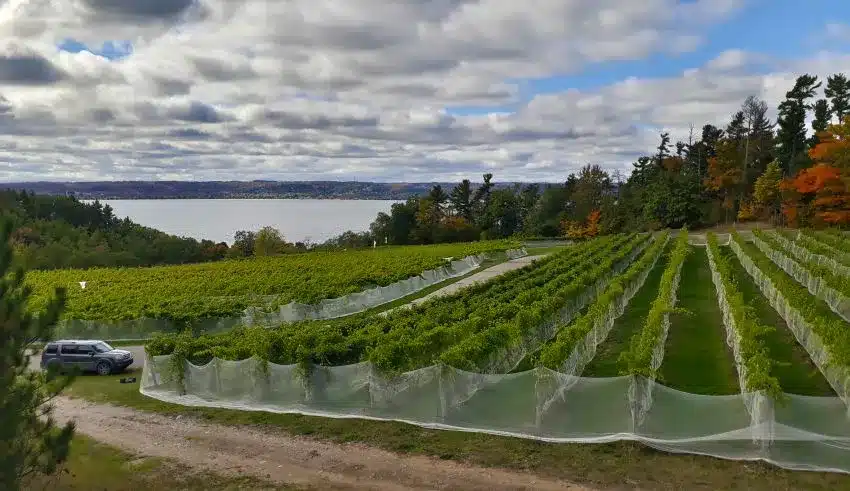Birds cause significant economic damage to vineyards. Data from Bird Gard shows that without active bird control, growers may lose 22% to 42% of their crops. Falcon Force supports this, noting crop losses due to birds in large vineyards can reach 10-20%. This figure might be even higher in smaller vineyards, sometimes resulting in total loss.
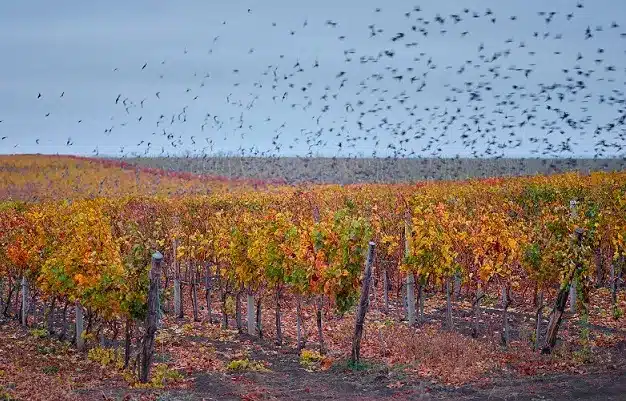
Bird Damage to Vineyards
Vineyards can use various bird control methods like sound repellents, taste deterrents, or visual scares like predator replicas to combat this challenge. However, sound and taste repellents often need reapplication and are ineffective. Visual deterrents, like predator replicas and reflective strips, are cheaper but not always effective and require substantial maintenance. In contrast, bird netting offers a lasting and comprehensive solution.
How Does Bird Netting Work?
Common vineyard birds like starlings, blackbirds, and sparrows vary in size but are generally small to medium. Bird netting typically has mesh sizes between 1 to 2 square centimeters, covering the vines in a grid pattern. It effectively isolates birds larger than the mesh, preventing them from accessing the grapes.
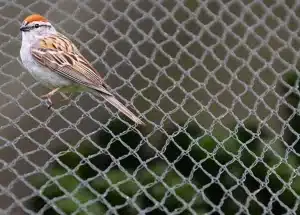
Anti-Bird Netting Mesh
Moreover, with openings over 1 square centimeter, the netting allows sufficient sunlight, air, and beneficial insects like bees to circulate, promoting healthy grape growth. The choice of specific mesh size, material, and weaving style should be based on local bird species and size, as these factors directly affect the netting’s durability and effectiveness.
How to Select the Right Bird Netting for Vineyards?
When choosing bird netting for vineyards, several key factors must be considered to ensure product effectiveness and durability. First and foremost is product quality, including material, mesh size, and ease of installation.
The material’s environmental impact — whether recyclable or biodegradable — is crucial to minimizing potential soil and environmental harm. Additionally, cost-effectiveness is important, assessing whether the product price is reasonable. Furthermore, the supplier’s production capacity and reliability, especially timely delivery, should not be overlooked. However, here, we’ll focus mainly on factors related to product durability.
1. Material Used
Understanding different materials is vital when selecting bird netting for vineyards, as it directly impacts the net’s durability, effectiveness, and cost-efficiency. Common materials include polypropylene, nylon, and high-density polyethylene (HDPE).
- Polypropylene is lightweight yet sturdy, often used in cost-effective nets. Its main advantages are good chemical resistance and moderate durability, making it an economical choice. However, its UV resistance is weaker than nylon or HDPE, potentially affecting its lifespan in strong sunlight.
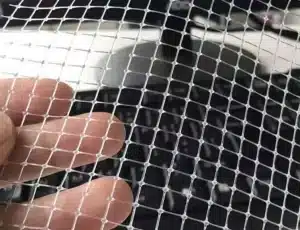
PP Bird Netting
- Nylon nets excel in strength and durability. They usually withstand stretching and tearing better, making them a sturdier choice. They also show better UV resistance, but long-term sun exposure can still cause gradual degradation. Nylon nets are typically costlier than polypropylene and HDPE, but their enhanced durability might offer better long-term value.
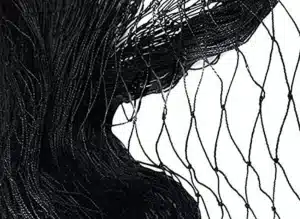
Nylon Bird Netting
- HDPE is the preferred material for high-quality bird netting. Known for outstanding durability and UV resistance, it withstands harsh weather, like strong winds and cold. HDPE nets usually offer a longer lifespan than polypropylene and nylon, making them a more economical choice in the long run. Though the initial investment might be higher, their lasting performance and reduced replacement need to make HDPE a cost-effective option to consider.
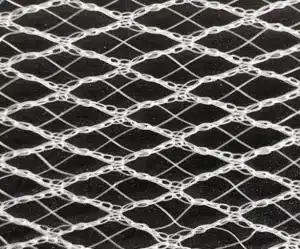
UV-Stabilized HDPE Bird Netting
2. Weaving Method
Besides material, the weaving method is a key factor in net performance. Main weaving types include monofilament, multifilament, knotless, and stretched nets.
- Monofilament weaving uses a single continuous thread, producing stronger and more durable nets. Their tear resistance and anti-pecking ability make them more effective against birds. However, this high-strength weaving often means higher costs.
- Multifilament weaving intertwines multiple thin threads. These nets are typically cheaper than monofilament, making them ideal for limited budgets. However, they are usually less durable and more prone to damage. But their easier repair partially offsets this disadvantage.

UV-Stabilized HDPE Bird Netting
- Knotless weaving is used in high-end bird nets. These nets maintain shape under pressure, not easily deform. Knotless nets usually surpass other types in durability and bird prevention but at a higher cost. They are especially suited for applications requiring long-term durability and effectiveness.
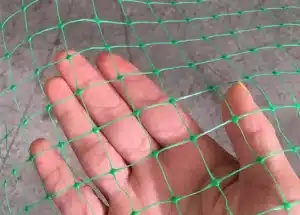
Processed HDPE Bird Netting
- Stretched nets are made by processing plastic sheets into a net structure. They are lightweight and easy to install, ideal for quick deployment. However, they generally lack the sturdiness of woven nets.
3. UV Resistance
UV radiation accelerates the aging of plastics and other synthetic materials. This factor is crucial for choosing more durable bird netting for outdoor vineyards with strong sunlight. You should inquire with agricultural net suppliers if the products contain UV stabilizers.
UV stabilizers are chemical additives that slow down material degradation under sun exposure. Almost all bird net materials can incorporate UV stabilizers to enhance their resistance and durability.
- For HDPE and polypropylene: These materials often include UV stabilizers due to their natural sensitivity to UV light. Adding these stabilizers significantly extends their lifespan.
- For nylon: Nylon has good natural UV resistance, but adding UV stabilizers further enhances its durability, especially in direct sunlight.
- Impact on Weaving: Whether monofilament, multifilament, or knotless, adding UV stabilizers is feasible. This additive is incorporated during material production, so it’s independent of the weaving process.
How to Install Bird Netting in Vineyards?
Whether your vineyard is large or small, choosing the right installation time and method is crucial for protecting grapes from birds. Considering regional climate differences and grape maturation cycles, it’s essential to schedule installation for optimal protection during growth and harvest.
Choosing the Installation Time
Firstly, picking the right installation time is key to your vineyard’s smooth growth and protection. Ideally, install before the fruit starts to mature but after pollination ends. This balance varies by region. For example, in major Northern Hemisphere regions like Bordeaux, France, or California, pollination usually ends in late spring. Thus, early to mid-June is optimal for installation. In Southern Hemisphere areas like Australia or Chile, pollination typically ends in November, making early December ideal for installing bird netting. Adjust the installation time based on your region’s climate and grape growth cycle to ensure the best growth and protection.
Methods of Installing Bird Netting in Vineyards
A simple single-row drape net might be the best choice for small vineyards. These nets are easy to install and remove and suitable for small-scale growers with limited labor and resources. Based on local maturation timings, install when grapes are nearing but not fully mature.
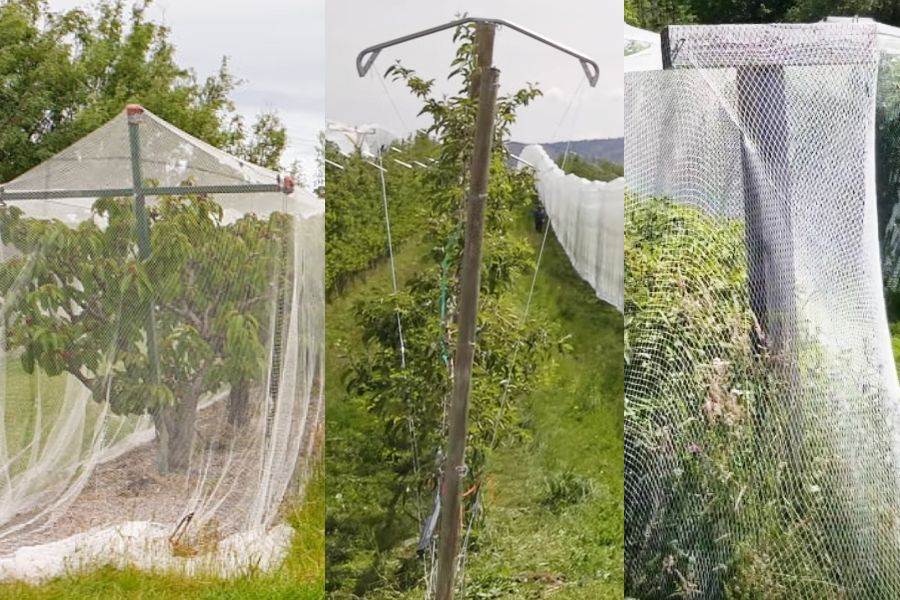
Draped netting support
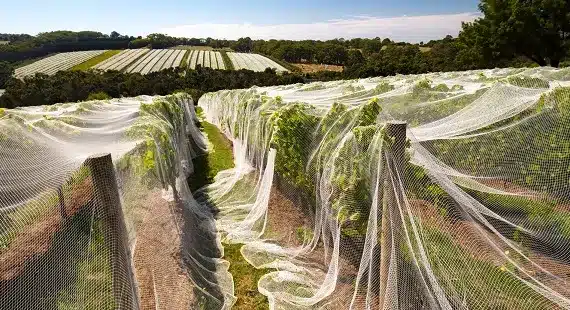
Multi-Row Draping Bird Netting
For larger vineyards, consider more comprehensive coverage, like multi-row drapes or overhead nets. For such large-scale installations, particularly in areas with high labor costs or shortages like Italy or Spain, consider using fruit tree net laying machines to expedite the process.
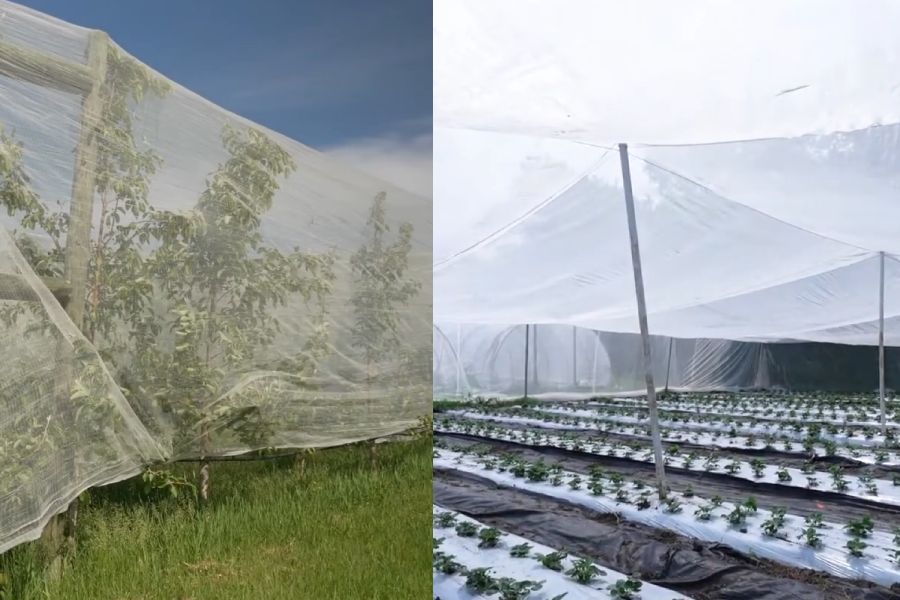
Draped netting vs overhead netting
Conclusion
Choosing the right bird netting for your vineyard is a wise decision. This article has detailed how to select bird netting based on specific vineyard conditions, including material, weaving method, and UV resistance, along with installation considerations.
Thank you for reading. We hope this article provides useful guidance and help in selecting and installing bird netting for your vineyard. We are a leading agricultural net manufacturer in Southwest China. If you have any questions or need more information about custom bird netting and bulk purchases, please contact us. Wishing your vineyard abundant growth and a bountiful harvest!
